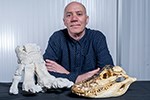Humble fruit fly demonstrates that wing shape is crucial for peak performance
RVC Press Release 01 March 2016
Researchers at The °ÄĂĹÁůşĎ˛ĘąćÂÉÂŰĚł, University of London, have demonstrated the link between animal wing shape and aerial performance.
Using genetic methods, they altered the wing shape of fruit flies and not only changed their flight performance but even improved their agility.
Wing shape and performance varies dramatically in the insect world. When invading a summer’s picnic or buzzing around the fruit bowl in your kitchen, fruit flies seem to be agile and manoeuvrable insects. In fact, as in all animals, their evolutionary design is a trade-off of performance and economy. In other words, some agility is sacrificed for efficiency.
The team, led by Dr Richard Bomphrey (°ÄĂĹÁůşĎ˛ĘąćÂÉÂŰĚł) and Dr Robert Ray (Francis Crick Institute) raised flies with a range of wing shapes and modelled how the variation should affect aerobatic performance and fuel economy. The novel flies’ wings developed to be broader at the base but more pointed at the tip than those found in the wild. To the researchers’ surprise, in free flight experiments, the flies with altered wings were substantially quicker around corners. Further careful analysis revealed the mechanical causes of their enhanced agility. Their work is published today (1 March 2016) in Nature Communications.
The consequences of such changes can mean the difference between life and death in a fly’s natural habitat. Fruit flies face many dangers but more agile fruit flies have a better chance of out-manoeuvring a pursuing dragonfly predator. On the other hand, these encounters are relatively infrequent and day-to-day fuel economy is also a major concern.
Using a genetic technique called targeted RNA-interference, the researchers were able to manipulate the development of the fruit flies’ wings, tipping the balance away from its compromised evolutionary design and towards one of higher performance.
Once the changes had been made to the wings, the researchers then tracked the flies using stereo high-speed cameras recording at 500 frames per second, reconstructing their 3-dimensional flight trajectories to calculate the speeds, accelerations and turning circles of the flies.
The team found that reducing the expression of a single gene can significantly enhance aerial agility. However, the new wing’s shape, whilst more manoeuvrable, was significantly less efficient, and required a lot more energy for flight.
The experiment shows the huge effect that changing the expression of just one gene can have on flight performance and also offers insight into the evolutionary mechanisms underlying the diversity of insect wing geometry. The technique also begins a new direction for experiments on the evolution of performance specialities in animals.

Reader in Biomechanics at the RVC, Dr Richard Bomphrey, said, “This is a classic example of a trade-off in nature. Evolved designs are always a compromise between different objectives: in this case agility vs. economy. It is often the same in our own vehicle designs: do you want high performance or more miles per gallon?
“Here, we have been able to change the expression of a single gene to tip the balance from the natural solution towards a more agile fly. It is fantastic to be able to understand the balance of this complex system from the level of the gene and development, right through to life-and-death aerobatics.”
Lead author, Dr Robert Ray added, “"By using genetic technology to alter wing morphology, we not only alter wing shape non-invasively, but also generate shapes that are evolutionarily accessible to the organism -- our technique generates wing shapes that could potentially arise by natural selection -- making our approach a powerful [new] technique for addressing the interplay between form and function."
Research Reference
“Enhanced flight performance by genetic manipulation of wing shape in Drosophila.” Robert P. Ray, Toshiyuki Nakata, Per Henningsson and Richard J. Bomphrey. Nature Communications (2016)
Press Office Contact
Uche Graves / Zoe White
T: 0800 368 9520
E: uche.graves@plmr.co.uk / zoe.white@plmr.co.uk
Notes to Editors
The °ÄĂĹÁůşĎ˛ĘąćÂÉÂŰĚł (RVC) is the UK's largest and longest established independent veterinary school and is a constituent College of the University of London. The RVC offers undergraduate, postgraduate and CPD programmes in veterinary medicine, veterinary nursing and biological sciences, being ranked in the top 10 universities nationally for biosciences degrees. It is currently the only veterinary school in the world to hold full accreditation from AVMA, EAEVE, RCVS and AVBC.
A research-led institution, in the most recent Research Excellence Framework (REF2014) the RVC maintained its position as the top HEFCE funded veterinary focused research institution.
The RVC also provides animal owners and the veterinary profession with access to expert veterinary care and advice through its teaching hospitals; the Beaumont Sainsbury Animal Hospital in central London, the Queen Mother Hospital for Animals (Europe's largest small animal referral centre), the Equine Referral Hospital, and the Farm Animal Clinical Centre located at the Hertfordshire campus.
See other Press Releases.
You may also be interested in:
-
RVC’s Professor John Hutchinson elected Fellow of prestigious Royal Society
John Hutchinson, Professor of Evolutionary Biomechanics at the °ÄĂĹÁůşĎ˛ĘąćÂÉÂŰĚł (RVC), has …

